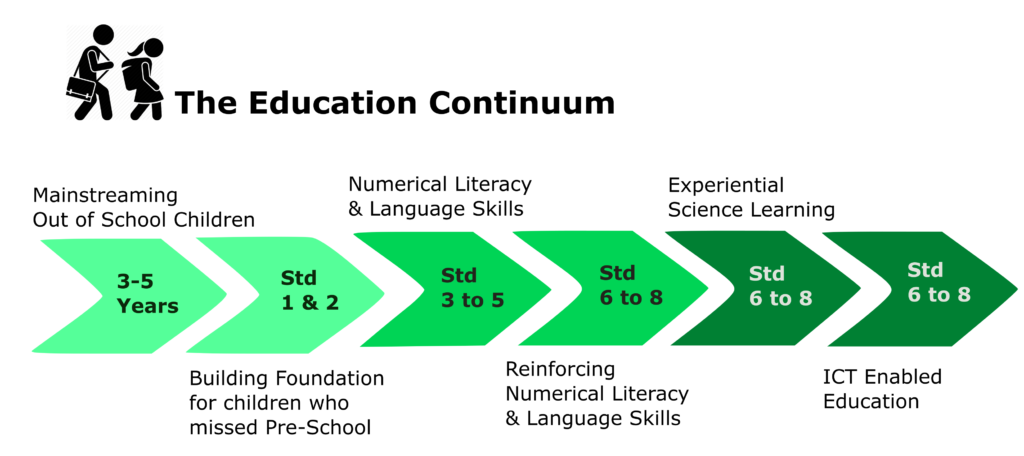Commitment to a Continuum Model for Education – A CSR Strategy.
Businesses are expected to become more profitable and to operate ethically and responsibly. They are also expected to give back to society in the form of donations of time, money and goods. These expectations have set corporate boards thinking about how to make CSR contributions effective. Such effectiveness requires choosing an appropriate cause and strategy for their CSR spends. The boards’ approach ranges from investing in familiar non-profits to investing in different causes and combining CSR with employee volunteering. All these approaches generally target doing good things for society. But often they don’t adequately respond to the development problem at hand. This is why having a CSR strategy and partnering with the right implementing agency over a mid-long term is crucial to ensure a balance between corporate ethos and societal priorities.
We believe that corporates which leverage their core competencies to drive CSR, raise the bar for innovation in the development sector. In our experience, CSR programs that support responses to systemic aspects of a development issue, and fund initiatives with a holistic approach of problem-solving, see sustained and long-term benefits for their stakeholders and beneficiaries.
Based on our work with corporate boards of various companies, we found the strategy of a US based multinational technology company deeply insightful. The strategy dealt with education as a central theme and invested in programs around the beneficiary requirements, in this case students. Also, it created a continuity as exemplified in Image 1. To avoid investing in parallel infrastructure, all the interventions are with government schools. This approach becomes important and effective given that small CSR budgets can reach out to a larger number of beneficiaries.

The beneficiaries for their programs were children in the age groups of 3 years to 14 years. The initiatives ranged from getting the out-of-school children into mainstream schools by working with the primary and upper primary schools . Also, these out-of-school children belonged to migrant labourers, especially construction workers in urban areas.
Furthermore, evidence suggests that primary school children in Stds 1 and 2 miss formative years of pre-schooling and may develop learning difficulties. A remedial program for Stds 1 and 2 helps to bridge the learning gaps at these initial stages. The next initiative focuses on improving language skills and numerical literacy of Stds 3 to 5.
For the upper primary school Stds 6 to 8, the focus was on experiential science learning techniques. The experiential learning program works through access to practical, hands on science education which reinforces science concepts. Science labs and visits to a science centre are used for this purpose.
Another innovative pilot program targetted Stds 6 to 8. In this program, content was digitised based on course curriculum with the support of SCERT and DIET (District Institute of Education and Training). The curriculum was delivered using ICT technology. Video Conferencing was used to connect the schools with each other and to hold of joint classes. This helped address the issue of shortage or absenteeism of teachers which is prevalent and plagues the current education system.
The Company has followed this consistent approach towards beneficiaries and has continued to operate in the same schools for the last four years. This has helped in supporting the same set of children as they move to higher classes, hence the continuum.
The non-profit world operates on a continuum approach which forms their theory of change. Teach for India’s philosophy is to continue supporting the same set of beneficiaries, continuously through their learning journey in schools. Pratham uses the pedagogical approach of “Teaching at the right level” (TaRL) to educate students according to learning level rather than age or grade.
The TaRL approach has recently been lauded for its effective use in the graded learning program (GLP) in Uttar Pradesh (UP) since its launch in August 2018 [1]. GLP ha sbeen rolled out and implemented in all of the 75 districts of UP. The focus of GLP was to reorient teaching to the level of the student (rather than the rigid expectations of a curriculum). GLP also focussed on introducing and sustaining innovative teaching-learning practices in schools. Within three months of implementation, 1.7 million children in grade 3 and 4 were being able to read basic texts in Hindi at grade 1 level.
Finally, to move the needle of learning outcomes, a consistent approach which responds to systemic challenges in education, is important. It is a fact that contributing to Education is an investment which generates invaluable benefits for the future. Hence it would be good to see companies’ CSR initiative spending more on learning outcomes and pedagogy than on infrastructure.
References
[1] A quiet revolution: The case of primary education in Uttar Pradesh ( Ideas for India, Blog Post, Date 31 May, 2019) https://www.ideasforindia.in/topics/governance/a-quiet-revolution-the-case-of-primary-education-in-uttar-pradesh.html

